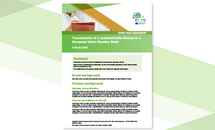Threat Assessment Brief: Implications for the EU/EEA of the spread of the SARS-CoV-2 Omicron XBB.1.5 sub-lineage
According to the current ECDC assessment, there is moderate probability of XBB.1.5 becoming dominant in the EU/EEA and causing a substantial increase in the number of COVID-19 cases within the next one to two months.
Executive Summary
The XBB.1.5 Omicron sub-lineage was first detected in samples in the United States (US) in October 2022. This sub-lineage has been growing in proportion in the US and many countries around the world since then, including in several EU/EEA countries and the UK. XBB.1.5 is a sub-lineage of XBB, which is a recombinant of two earlier lineages of the Omicron variant of concern (VOC), with an additional spike receptor-binding domain (RBD) change S486P. The reported proportion of XBB.1.5 in the EU/EEA has been lower than 2.5% for the last two weeks of 2022.
XBB.1.5 currently exhibits a daily growth advantage of 12% in the US compared to other circulating variants. It is plausible that the difference in growth rate between XBB and XBB.1.5 is mainly explained by a difference in transmissibility. In addition, XBB and XBB.1 demonstrate the most substantial immune escape observed amongst Omicron sub-lineages to date, with significant reductions in the neutralising capacity of serum from vaccinated individuals. Preliminary in-vitro data show the immune escape properties of XBB.1.5 are equivalent to XBB.1.
While there are currently no vaccine effectiveness (VE) estimates for XBB.1.5, the available vaccines still remain effective against severe disease due to previous and current Omicron variants dominant in the EU, even though there is some evidence of waning over time.
There are currently no signals that the infection severity of XBB.1.5 is different than that of previously circulating Omicron sub-lineages. Regarding therapeutics, no specific data exist on the effectiveness of therapeutics such as nirmatrelvir/ritonavir or remdesivir for XBB.1.5, however the variant is expected to be as susceptible to these antivirals as XBB has shown to be.
Mathematical modelling performed by ECDC provides estimates of when XBB.1.5 might become dominant (i.e. causes more than 50% of infections) in the EU/EEA by using a broad range of scenarios with hypothetical values of the growth rate advantage and of the current proportions of XBB.1.5 in the EU/EEA.
Download







